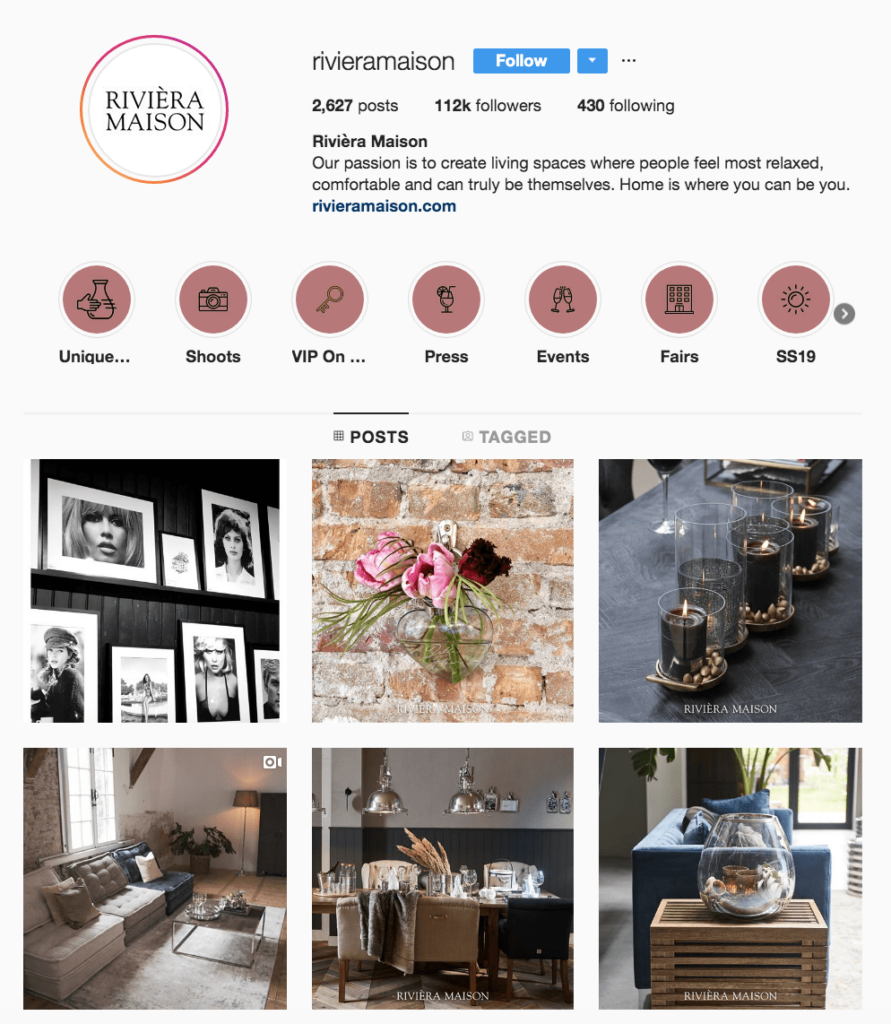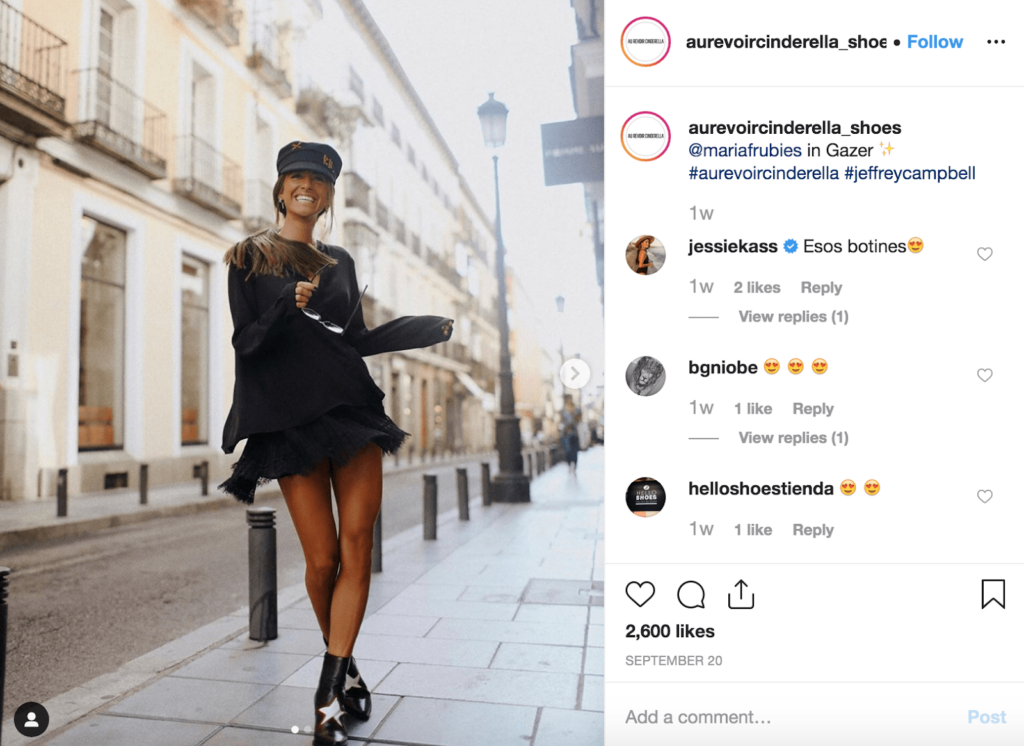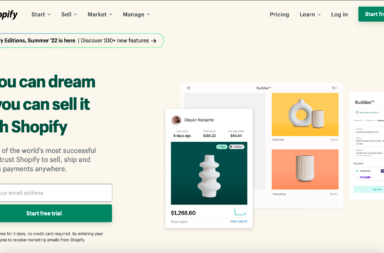Riviera Maison’s 112,000 Instagram followers get home decor inspiration pumped into their feeds every day.

For high-end brands like Rivera, giving customers the chance to see what their products look like in situ is an important step in the sales cycle. In the past, this would mean hiring a professional photographer to capture a few studio-style shots for the website.
Today, the possibilities have been blown wide open.
Riviera Maison shares photos from customers that have already bought their signature velvet sofa, mahogany sideboard, or luxurious winter blanket to provide endless decor inspiration for future prospects.
And this isn’t a one-off.
In fact, the rise of social commerce shows us that shopping is (and always has been) an inherently social experience. Social commerce sales are on the rise even in spite of a dropoff in in-person shopping. Ultimately, conversations about brands and products are still happening— in fact, they’re happening more often than ever before with social media.
In the current digital landscape, brands have a wealth of tools and opportunities at their fingertips. Savvy brands leverage their social power and build deeper connections with their buyers through social media platforms like Instagram, Facebook, Twitter, and YouTube. And YouTube ad agencies are helping brands implement this . Starting conversations and engaging with customers online doesn’t just generate valuable feedback and loyalty; it inspires current consumers to share what they love about the brand.
With more than 50% of all shoppers following their favorite brands on social media for the sole purpose of seeing new products, there’s no point denying the impact social can have on sales.
Social Selling In Action: Examples From 5 Real-Life Brands
1. “Shop Now” Insta Ads from Bombas
Bombas Socks taps the power of Instagram ads by encouraging shoppers to buy products directly through the social media app itself.
Each ad is designed to stand out in a prospective customer’s feed, employing bright colors and quirky styling, and using the “Shop Now” call-to-action banner that Instagram ads provide.
As a result, shoppers can make their purchase in one window, without ever having to leave Instagram, reducing friction that might otherwise decrease the likelihood of a sale. Once the purchase has been made, they can continue to scroll through their feeds.
The in-built nature of buying through social media demonstrates just how much online shopping has become a part of everyday life. Consumers can now impulse buy like never before with just a few clicks.
Key Takeaway From Bombas
Studies show that 60% of users learn about new products through Instagram. Online communities have evolved, and consumers are now open to purchasing through channels that were originally reserved for interacting with friends and keeping in touch with family.
In fact, one-third of Instagram users have actually bought something through the platform while on their mobile device.
Take Bombas’ example and serve stand-out ads that link directly to a in-app purchase window, making it as easy as possible for potential customers to make a purchase while going about their everyday activities on Instagram.
2. Shareworthy Giveaways by Friend’s Beauty
The main goal for social media savvy eCommerce brands is to generate engagement and interaction. The more buzz that’s created, the more chance they have of reaching new audiences and creating a loyal following that continues to buy their products.
Increasing engagement is the exact outcome Friend’s Beauty wanted to achieve by hosting a giveaway. They encouraged their Facebook followers to comment and share their giveaway post, ultimately increasing its reach on the platform.
As a result, the brand created a digital version of word-of-mouth marketing (which still remains one of the most effective forms of marketing ever).
Today’s consumer relies heavily on peer recommendations simply because there are so many brands out there to choose from. (Read more on consumer decision fatigue in the latest from Rodger Smith, CEO of DirectScale, an Exigo company.)
They tend to lean toward companies that come recommended by friends and family, because they trust those people more than the word of businesses themselves.
Key Takeaway From Friend’s Beauty
Sharing is a core part of social media. People who use Facebook are primed to share content with their friends list that either makes them look good, is entertaining, or has some kind of potential personal benefit (in the case of the Friend’s Beauty giveaway, the chance to win an eyeliner and brush set).
Take advantage of user’s innate need to share on social media by generating posts that encourage word-of-mouth marketing.
This might come in the form of a giveaway, or it might simply be a “tag a friend” post, like Sephora does here:
3. Customer Created Content by Batoko
In an age where consumers are cleverer than ever, creating human connections has never been more important.
Brands are turning their backs on highly-polished marketing campaigns and are instead showcasing content that’s been created by their very own customers.
93% of shoppers note that user generated content helps them decide whether to buy a product, and brands like Batoko are tapping into this powerful trend.

The recycled swimwear company exclusively shares customer photos on their Instagram feed.
Not only does this show their products in a range of different environments and on a range of different bodies, but it also works as unbeatable social proof. It says “hey, look at all the people who’ve bought from us already and love our product!”.
Key Takeaway From Batoko
Steer clear of highly-polished campaigns that consumers are becoming more and more skeptical of and instead showcase content that’s been created by your loyal fans.
Encourage users to send in and post their photos using a specific hashtag, or bring influencers on board (like Au Revoir Cinderella have done below) to solidify your social proof.

4. Getting Real With Stories by Zit Stick
Instagram Stories are on fire.
They inject a sense of “realness” into a platform that is renowned for intensely edited images that show only the best parts of life.
Since their introduction to Instagram in 2016, Stories have become a tool for eCommerce brands to demonstrate the human side of their business and forge deeper connections with their audience.
In fact, Stories are so successful for online shops, that one in four millenials and Gen Zers actively seek out Stories that feature the products and services they want to buy.
Zit Stick buys into this need by populating their Stories with customer testimonials and real-life stories that lead into a call-to-action (or a “Swipe Up” to buy image).
Their Stories show the products in action and share testimonials from customers who have bought and enjoyed the product (which again acts as a form of good old word-of-mouth marketing).
Key Takeaway From Zit Stick
Let customers do the talking for you and incorporate their testimonials and experiences into a Stories thread.
Once viewers are invested in the outcome, add a call-to-action that encourages your audience to “complete the story” by making a purchase.
Stories are a great way to show the behind-the-scenes of your brand (which ultimately builds relationships with customers), so don’t be afraid to share silly moments, the making of your products, or other raw, unpolished aspects of your brand.
5. Shop Spring
With so many options available today, it’s important for eCommerce brands to stand out – and a huge part of that involves making sure your customer service is spot on.
Think about it:
If a consumer lands on your site and has questions about one of your products but can’t get an answer, they’ll go elsewhere to a place where they can get the answer in a timely manner.
To combat the challenge of site abandonment, many brands are implementing Facebook Messenger or other chatbots to answer simple questions and to personalize the online shopping experience, suggesting products the customer would like based on their interactions with the bot.
Shop Spring’s Facebook bot is a prime example.
By using a machine-learning powered “robot,” Shop Spring answers immediate objections or questions consumers have to keep sales flowing.
Impulse buying is becoming hotter than ever, and if a shopper is in the mood to buy right now, you must be able to accommodate that. Otherwise, the critical moment of impulse will pass, and you’ve lost a sale.
It’s also worth noting that Shop Spring’s chatbot is used on a platform that most of its customers are familiar with.
It doesn’t ask them to submit a form on a page they’ve never seen before.
Instead, it turns up in their Facebook Messenger inbox amongst threads from their friends and family.
Key Takeaway From Shop Spring
In addition to implementing a customer service portal on a platform that your customers are familiar with, the Facebook Messenger chatbot allows you to personalize the shopping experience.
If you can recommend products they might also like based on their interactions with your chatbot, you are ultimately going to encourage more sales.
Social Selling to Get More Sales
The evolution of free and paid social media services means it’s no longer just a place for keeping in touch with friends and family. Instead, it provides a platform where users do many other everyday activities without having to leave the safety of a platform they know and love.
As a result, eCommerce brands must grow their social presence and interact with their customers, through mediums like authentic Instagram Stories, YouTube Ads AI-powered Facebook Messenger chatbots, or customer-created content.
If you’re not already engaging with your customers on social media, you’re missing out on chances to build your brand, create royalty, and even make sales directly.
–


